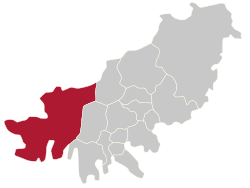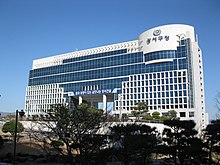
Back Gangseo-gu (munisipyo sa Habagatang Koreya, Busan) CEB Gangseo-gu (Busan) German Gangseo-gu (Busan) Spanish Gangseo ringkond (Busan) Estonian Gangseo-gu (Pusan) French Distrik Gangseo, Busan ID Distretto di Gangseo (Busan) Italian 江西区 (釜山広域市) Japanese Dhistrik Gangseo, Busan JV 강서구 (부산광역시) Korean
Gangseo
강서구 | |
|---|---|
| Korean transcription(s) | |
| • Hanja | 江西區 |
| • Revised Romanization | Gangseo-gu |
| • McCune–Reischauer | Kangsŏ-gu |
 | |
 | |
| Country | South Korea |
| Region | Yeongnam |
| Provincial level | Busan |
| Administrative divisions | 8 administrative dong |
| Area | |
| • Total | 179.05 km2 (69.13 sq mi) |
| Population (2015 May 31[1]) | |
| • Total | 84,558 |
| • Density | 470/km2 (1,200/sq mi) |
| • Dialect | Gyeongsang |
| Website | Gangseo District Office |


Gangseo District (Korean: 강서구; RR: Gangseo-gu) is a gu on the west side of Nakdong River in Busan, South Korea. It has an area of 179.05 km2, and a population of about 66,000; it has a lower population density than Gijang County of Busan. Gangseo-gu was part of Buk-gu from its creation in 1978 to 1989 when it became an independent gu.
Gangseo-gu is the westernmost gu in Busan and it shares a common borders with Gimhae on its north-west side and Jinhae District, Changwon on its south-west side.
Gangseo-gu is the birthplace of the Gaya civilization.
Gimhae International Airport, Heungguk Temple, Myeongwol Temple, as well as the Eulsukdo bird sanctuary are located in Gangseo-gu.
- ^ ":: Gangseo District ::". Archived from the original on 2007-09-28.

